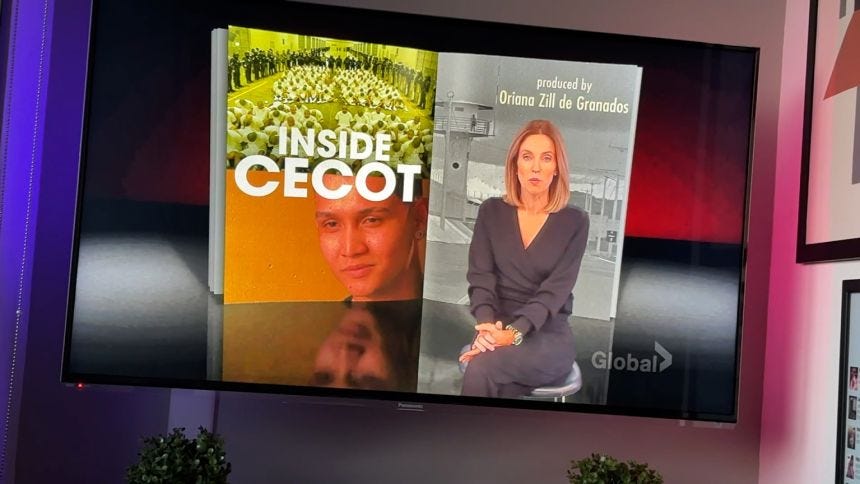Do you have any idea how much of a bumbling just-picked-up-a-paintbrush amateur Bari Weiss is in her new job as Editor-in-Chief of CBS News? I’ll tell you. She killed the big “Inside CECOT” story about the torture prison in El Salvador that was supposed to run on “60 Minutes” Sunday night. The story involved the Venezuelan immigrants who were flown by Trump’s ICE, against a judge’s order, to El Salvador, where in the prison they were beaten and sexually assaulted. Weiss told the producers that one of the things the story needed was an in-person interview with chief immigration Nazi, Stephen Miller. She helpfully provided them with Miller’s contact information, you know, because Bari Weiss is so plugged-in that she has stuff like White House phone numbers and email addresses at her fingertips.
There are several “as if’s” here. As if the producers hadn’t thought about interviewing Miller themselves. As if they hadn’t already contacted his office and requested an interview or at least on-the-record comments for the DECOT story. As if the damn “60 Minutes” team hadn’t been doing this kind of reporting better than anyone on the planet for the last 56 years.
Can you think of another bumbling amateur who is running a large organization he is not qualified to run? Hmmmm…let’s see…could it be Pete Hegseth? You remember Major Hegseth, who hadn’t run anything larger than a small non-profit supporting veterans before he became Secretary of Defense and was put in charge of more than 4.5 million uniformed and civilian people who work for the Department of Defense. Hegseth was the genius who included his wife, brother, and the editor for The Atlantic in a chat group on Signal as the Navy and Air Force bombed and rocketed Houthi strongholds in Yemen back in March, during which he shared the exact times of attack, what aircraft were involved, and what weapons they were using – all of this in real time as the attack was taking place.
We know enough about Pete to last us about 3 extremely unpleasant lifetimes. Let’s have a look at Bari. I’m not going to bore you with the story of her career as a junior editor at the Wall Street Journal and her time writing for and occasionally editing stories for the New York Times editorial section. Enough ink has been wasted on her dramatic resignation from the paper citing the firing of editorial page editor James Bennet and alleged “bullying” by Times staff members for her conservative political views.
Weiss worked for other people at both the Wall Street Jornal and the Times. She had no authority over other employees in either job. It was after her departure from the Times that she became an executive of a conservative-leaning Substack called “The Free Press.” I’m sure her newsletter on Substack, which the press refers to as a “media company,” made quite a bit of money and employed more people than Weiss herself before it was acquired by Paramount Skydance this year for $150 million.
But she could only have been in charge of a tiny fraction of the estimated 1,700 to 2,500 employees who work for CBS News. And as practically every article written on Weiss has noted, she had zero experience in television or running a large news-gathering organization.
Wow. Maybe Pete and Bari should get together for coffee sometime. She could give him advice on dealing with recalcitrant generals who have no respect for him, and he could tell her a thing or two about how to handle reporters who are going through your drawers asking questions you don’t want to answer.
The problem both have is that they were thrust into jobs that are clearly more than they can handle for political reasons, not because they had spent careers building up expertise in their fields. Well, at least Weiss can be said to have had a field with journalism. I don’t know what the fuck Hegseth’s career amounted to before he walked into the Pentagon, other than flexing his muscles to show off his Nazi tattoos and blathering on Fox and Friends on weekends.
Weiss now has the newsmagazine “60 Minutes” under her control, along with its staff of veteran reporters and producers, not to mention camera and sound people, many of whom have done their jobs in combat zones and places on the planet no person not working for “60 Minutes” would want to find themselves. I’m sitting here at my desk in Milford, PA, writing my Substack column, so I am certainly not putting down Substack as a place of business that can give you experience conveying information to a readership and these days, with live video and video podcasts, a viewing audience. But the Substack “media business” Weiss developed and sold for an obscene quantity of greenbacks did not qualify her to pick the outfits for CBS on the air talent, much less run its worldwide news gathering network.
I have some experience with “60 Minutes,” having been interviewed on the program twice. Let me tell you just a little bit about what that’s like. Getting a call from a “60 Minutes” producer is, I’m not exaggerating, life changing. It isn’t the prospect of “being on TV” and how that might change things in your life and career, which can of course happen. It’s…there is no other word for it…gravitas. You’re on the phone, and you’re thinking, even given all the reporting and writing and covering big stories I’ve done, these people are the fucking big leagues!
Because they are. Their standards are at the top of television news. I don’t mean near the top. I mean the top. Before they even call you, much less interview you on camera, they know everything that can be known about you and what you have to do with the subject of the interview. For one story, they knew everything I had written about the West Point honor code, and they knew as much as anyone could know about a then recent scandal involving cheating at the Academy.
To be honest, it was a little scary. You’re thinking, what did I write that they’ve read? Was I wrong about any of it? Was there anything I learned about the subject after the story was published? Because you can count on it that they know if anything changed between the time of your story and the interview with “60 Minutes.”
There was a third time that I was supposed to be interviewed by “60 Minutes.” It was 1998, and I had written an op-ed page story for the Times about the school shooting in Jonesboro, Arkansas. An 11-year-old and a 13- year-old had taken guns owned by one of their grandfathers and killed 5 people and wounded 10 at the middle school they attended. It turned out that both boys had been trained by their parents at a so-called “practical shooting course,” which taught them how to shoot rifles at human silhouette targets at various distances. My story pointed out the moral incongruity of teaching children to use high-powered rifles in exactly the same way I had been trained to use them in the Army.
Before being called by “60 Minutes,” I had been interviewed by Katie Couric on the Today Show about the Jonesboro shooting. On the program with me was the chief spokesperson for the NRA, Tanya Mataxa, who was poo-pooing everything I said as liberal claptrap even though I had been introduced as a gun owner and military veteran with extensive firearms training. Let’s just say, the interview wasn’t going well. Mataxa was filibustering, dominating the interview. Finally, there was a pause, and I asked Couric if I could ask Mataxa a question. Couric, obviously relieved, said “go ahead.”
I asked Mataxa if she thought teaching children to fire at targets in the form of human beings was good parenting, and if the NRA endorsed such “practical shooting courses” for children. Mataxa was stumped by the question. She was unprepared to take a stand in the name of the NRA. She filibustered until Couric interrupted her with “Answer the question, Tanya,” in an unusually loud voice for TV. Metaxa blinked into the camera and reached down on the floor next to her chair and picked up a copy of the Washington Post and opened it to a full-page anti-abortion ad and started shouting that “this is what we should be talking about! Killing babies!”
Shocked at this development, Couric shouted over her again: “Answer the question, Tanya!” Mataxa finally answered it, saying that the NRA stood behind parents who wanted to teach their children to shoot at human shaped targets.
I heard from friends with contacts in the NRA that Mataxa was almost fired for that answer. Time passed, and “60 Minutes” called wanting to interview me about school shootings. I said yes, of course, and we set up a time for their producers to come to New Orleans, where I was living at the time, to interview me.
A few days later, I got a call from the “60 Minutes” reporter who was scheduled to do the interview. They had to cancel the interview because no one from the NRA or any of the other pro-gun organizations such as the National Shooting Sports Foundation would appear on a program on which I was one of the interviewees. The reporter explained that they had called every pro-gun group they could find, and the answer was the same. They would agree to be interviewed only if I wasn’t on the program.
I told the “60 Minutes” reporter that if they went along with the demands of the pro-gun groups, they were effectively giving them the power to control who they interviewed and what viewpoints would get on the air. He apologized and said there was nothing they could do. They wanted to do a segment on school shootings, which were in the process of becoming a “thing,” so they would need to get someone else from a gun control group to interview on the show.
I have told this lengthy story, about which I have written before, because Blundering Bari proceeded to blunder into a very similar thing with “60 Minutes” over the CECOT story. The demand by Weiss that the CECOT segment wouldn’t air unless the producers interviewed someone from the Trump administration, preferably the odious Stephen Miller, effectively gave the White House veto power over what “60 Minutes” could put on the air. The Trump administration could continue to refuse to provide people to be interviewed for any story they had problems with.
When an email from Alfonsi leaked that discussed the issues raised by Weiss about the CECOT story, Weiss responded on a morning editorial call, essentially telling staffers that they should keep complaints in-house, implying that she had not been treated with “respect” in Alfonsi’s email about the dispute inside CBS News.
Just a squeak of irony from Bari Weiss, whose resignation letter from the New York Times, in which she complained about “wokeism” at the Times, became a cause celeb on the Right.
It’s too easy to say that this is what happens when incompetent and inexperienced fools are put in charge of large and powerful organizations such as the Department of Defense and CBS News. But fuck it. It is what happens. Bari Weiss would never have been hired at CBS News if its new owner, David Ellison, wasn’t the right-wing son of a right-winger who has given millions to Donald Trump, essentially buying the regulatory good will to gift his son a plaything he will use to keep the White House invitations coming for daddy.
We are already waist deep in dangerous political waters that threaten to swamp the First Amendment along with the 14th Amendment and every other Constitutional provision that Donald Trump doesn’t like, including the 22nd Amendment that limits a president to two terms in office.
Oh, well, we’ll have Bari Weiss picking stories for the CBS Evening News and “60 Minutes” that will tell us when the snakes and gators are about to gobble up all rights under the Constitution.
Won’t we?






